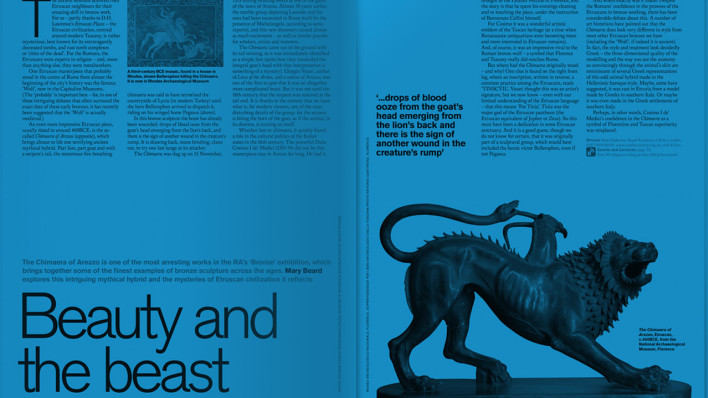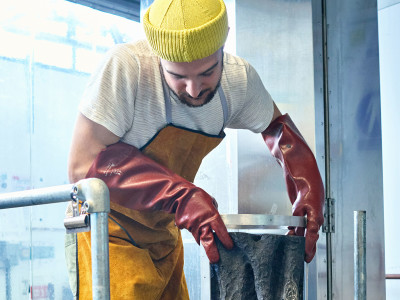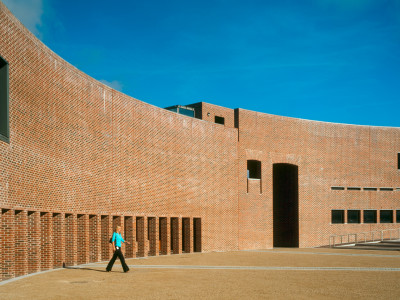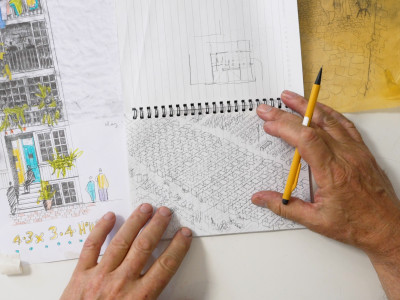
Thomas Heatherwick RA: "Inspiration is a cliché"
By Sam Phillips
Published on 27 August 2015
Thomas Heatherwick RA delights in discovering his ideas don’t work – it’s all part of a process of elimination that results in his extraordinary designs, as Sam Phillips finds out.
From the Autumn 2015 issue of RA Magazine, issued quarterly to Friends of the RA.
Thomas Heatherwick’s creations draw gasps. Flaming copper flowers converged to form his 2012 London Olympic Cauldron; his bridge over Paddington Basin curls up from one end like a caterpillar, transforming into a tight octagonal sculpture to allow canal traffic to pass by; the surface of his 2010 World Expo pavilion appeared as a porcupine, 60,000 silvery spines blowing around in the Shanghai breeze.
So unexpected are his structures that Heatherwick has always appealed to my clichéd idea of a genius: a man possessed of wild imagination, whose objects, artworks and buildings take me by such surprise that, surely, the ideas for them must have taken him too by surprise, arriving in a moment of revelation, or even a dream. Yet when I meet the designer Academician in his busy Kings Cross studio for the last in RA Magazine's series about artists’ epiphanies, he argues against any romantic view of his working process, and the idea of epiphanies in general.
"I deliberately, stubbornly oppose the notion of revelation," he says firmly, but kindly. "It has become popular in our time because people want to believe in inspiration and genius, as there is less confidence in religious divinity. Even the word 'inspiration' has an onomatopoeic quality that we enjoy – it sounds in the ear like a sudden flash of revelation. But inspiration is a cliché in everyone’s head. It’s what we think happens to people who develop ideas."
Inside Heatherwick STudio
British designer and inventor Thomas Heatherwick set up Heatherwick Studio in 1994, establishing a unique design practice with a spirit of discovery and invention at its heart. The Inside Heatherwick Studio exhibition is curated by Kate Goodwin, Head of Architecture and Drue Heinz Curator, Royal Academy of Arts, London. It is now touring Asia, supported by the British Council and the GREAT Britain campaign. Here, Thomas Heatherwick explains what he hopes visitors will take from their experience of the exhibition. Video courtesy British Council Arts.
Inside Heatherwick Studio: Materials
When he founded Heatherwick Studio at the young age of 24, Thomas Heatherwick further developed this ethos of experimentation, placing the workshop and the act of making at the heart of every design project. In this film he talks about his early experiments with materials. Video courtesy British Council Arts.
Spun Chair, 2010
Borrowing the idea of an industrial spinning process commonly used to produce drums and lamps, Heatherwick Studio created this Spun Chair. The studio re-thought the idea of a chair, producing several mock-ups to refine the design. The result is playful but functional, and challenges the very notion of what a chair is. Video courtesy British Council Arts.
Learning Hub, Nanyang Technology University, Singapore, 2015
At Heatherwick Studio, experimentation is integral to the act of making. The designers use the workshop to generate ideas and try things out, testing the boundaries of working with different materials. Here, curator Kate Godwin explains how this spirit of experimentation is carried right through to the building stage, with the studio often producing full-scale mock-ups to constantly refine the design during its production. Video courtesy British Council.
UK Pavilion, Shanghai World Expo, China, 2010
Heatherwick Studio’s design for the UK Pavilion at the Shanghai World Expo in 2010 was nicknamed ‘Dandelion’ by visitors to the event and was made from thousands of acrylic rods. The interior shape was defined by the ends of the rods, which held 250,000 seeds. Watch the film to see the Pavilion and its magical interior up close. Video courtesy British Council.
Heatherwick instead practises a gradual process of elimination, in which a series of "incremental realisations narrow down options, layer after layer, closing in on a final direction for a project, whether that’s designing an architectural masterplan or a detail of a balustrade." The process is propelled by what he calls "strategic worrying", productive anxiety at every stage of design that prevents him and his team from "jumping to assumptions or getting stuck with patterns of inherited thought".
It is the elimination of an option that he relishes. "When we realise something isn’t going to work, then there’s a jolt of excitement at that rejection, an excitement at the clarity of knowing what we shouldn’t do," he explains. "What we do in the end is often what’s left when we have eliminated all the other things we have considered doing. It’s like panning for gold."
Over 170 architects, designers and makers are hard at work in the office and workshop spaces around us, surrounded by Heatherwick-designed furniture, sleek surfaces brimming with books, prototypes and models, and some eccentric interior elements, including a wall covered by raised-relief maps (pictured at top).
The studio has been growing fast. Its work is the subject of two touring exhibitions – a show in Asia curated by RA Architecture Curator Kate Goodwin (see videos above), and another in the US. Major commissions are also in the pipeline, such as a joint-design project for Google’s headquarters in Mountain View, California, and London’s Garden Bridge, the controversial Thames crossing covered with grasses, plants and trees.
"The hero of that project is the garden, not the bridge, so we decided to design a structure that would hold up the garden and then get out the way." That decision prompted the project’s particular process of elimination, leading to the rejection of any suspension columns or cables that might distract from the horticulture, which means that if the project goes ahead, the 2,500 square metres of planting will be supported from below.
Before I leave, I ask whether Heatherwick, given his multidisciplinary work, is enjoying how artists and architects come together at the RA. But it seems that, again, I have got him wrong.
"I don’t see what I do as multidisciplinary – I see it as one discipline, the discipline of ideas," he counters. "Ideas can ossify if they are chopped up into different fields such as art, design and architecture. There is such an energy and momentum at the Royal Academy the moment, and I think there will be less distinction between everyone’s activities in the future."
Inside Heatherwick Studio is at PMQ, Hong Kong, from 5-23 September 2015. Visit the website for the exhibition here.
Sam Phillips (@SamP_London) is Editor of RA Magazine.*

Enjoyed this article?
As well as free entry to all of our exhibitions, Friends of the RA enjoy one of Britain’s most respected art magazines, delivered directly to your door.
Why not join the club?
Related articles

Crunch: inside the first Architecture Window display
14 February 2024

RA Architecture Prize Winner 2023: Shane de Blacam
1 September 2023
